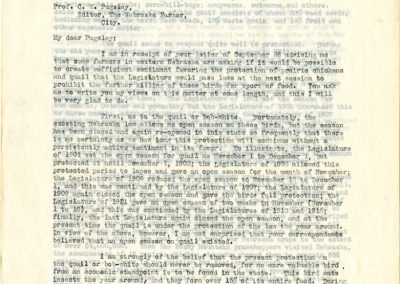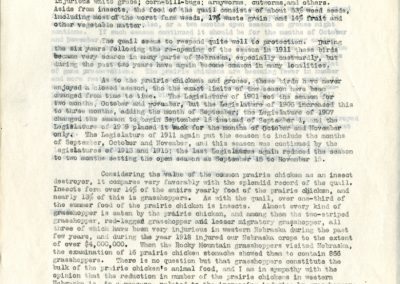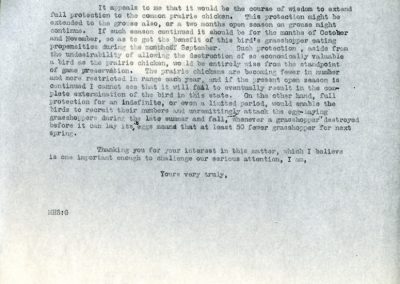Great Nebraska
Naturalists and ScientistsNebraska Ornithologists’ Union
Letters, 1918, October
1918, Oct. 1
October 1, 1918
Prof. C. W. Pugsley, Editor, The Nebraska Farmer, City.
My dear Pugsley: I am in receipt of your letter of September 26 advising me that some farmers in western Nebraska are asking if it would be possible to create sufficient sentiment favoring the protection of prairie chickens and quail that the Legislature would pass laws at the next session to prohibit the further killing of these birds for sport or food. You ask me to write you my views on this matter at some length, and this I will be very glad to do.
First, as to the quail or bob-white. Fortunately, the existing Nebraska law allows no open season on these birds, but the season has been closed and again re-opened in this state so frequently that there is no certainty as to how long this protection will continue without a persistently active sentiment in its favor. To illustrate, the Legislature of 1901 set the open season for quail as November 1 to December 1, but protected it until November 1, 1903; the Legislature of 1903 allowed this protected period to lapse and gave an open season for the month of November; the Legislature of 1905 reduced the open season to November 15 to December 1, and this was continued by the Legislature of 1907; the Legislature of 1909 again closed the open season and gave the birds full protection; the Legislature of 1911 gave an open season of two weeks in November (November 1 to 16), and this was continued by the Legislatures of 1913 and 1915; finally, the last Legislature again closed the open season, and at the present time the quail is under the protection of the law the year around. In view of the above, however, I am not surprised that your correspondents believed that an open season on quail existed.
I am strongly of the belief that the present protection on the quail or bob-white should never be removed, for no more valuable bird, from an economic standpoint is to be found in the state. This bird eats insects the year around, and they form over 15% of its entire food. During the summer months over one-third of the food of the quail is insects, most of them of notoriously injurious kinds. For instance, during a chinch outbreak in Nebraska a number of years ago we found the quails feeding on this unsavory insect, which most other birds avoided, to a remarkable extent, and one quail stomach examined contained more than 500 of these bugs, representing a single meal. Another injurious insect which very few birds will eat is the common Colorado potato beetle, yet from 75 of over 100 of these insects have been found repeatedly in the distended crop of a quail, and it is a well known fact that where these birds have nested about potato fields that spraying has rarely been necessary. During the
The quail seems to respond quite well to protection. During the six years following the re-opening of the season in 1911 these birds became very scarce in many parts of Nebraska, especially eastwardly, but during the past two years have again become common in many localities. As to the prairie chickens and grouse, these birds have never enjoyed a closed season, tho the exact limits of the season have been changed from time to time. The Legislature of 1901 set the season for two months, October and November, but the Legislature of 1905 increased this to three months, adding the month of September; the Legislature of 1907 changed the season to begin September 15 instead of September 1, and the Legislature of 1909 placed it back for the months of October and November only. The Legislature of 1911 again put the season to include the months of September, October and November, and this season was continued by the Legislatures of 1913 and 1915; the last Legislature again reduced the season to two months setting the open season as September 15 to November 15.
Considering the value of the common prairie chicken as an insect destroyer, it compares very favorably with the splendid record of the quail. Insects form over 14% of the entire yearly food of the prairie chicken, and nearly 13% of this is grasshoppers. As with the quail, over one-third of the summer food of the prairie chicken is insects. Almost every kind of grasshopper is eaten by the prairie chicken, and among them the two-striped grasshopper, red-legged grasshopper and lesser migratory grasshopper, all three of which have been very injurious in western Nebraska during the past few years, and during the year 1918 injured our Nebraska crops to the extent of over $4,000,000. When the Rocky Mountain grasshoppers visited Nebraska, the examination of 16 prairie chicken stomachs showed them to contain 856 grasshoppers. There is no question but that grasshoppers constitute the bulk of the prairie chicken’s animal food, and I am in sympathy with the opinion that the reduction in number of the prairie chickens in western Nebraska is, in a measure, related to the increasing injuries by grasshoppers and other insects in that part of the state. Like the quail, prairie chickens eat other insect pests if opportunity affords including Colorado potato beetles, cucumber beetles, May beetles, armyworms and cutworms, chinch bugs, etc. The vegetable food of the prairie chickens, which constitutes a little less than 86% of the food for the year consists of about 31% waste grain, 25% of leaves, flowers and shoots, 15% of weed seeds, and 15% of fruit and other vegetable material.
The sharp-tailed grouse is not quite so valuable a bird from the standpoint of the farmer as is the prairie chicken. Its insect food
It appeals to me that it would be the course of wisdom to extend full protection to the common prairie chicken. This protection might be extended to the grouse also, or a two months open season on grouse might continue. If such season continued it should be for the months of October and November, so as to get the benefit of this bird’s grasshopper eating propensities during the month of September. Such protection, aside from the undesirability of allowing the destruction of so economically valuable a bird as the prairie chicken, would be entirely wise from the standpoint of game preservation. The prairie chickens are becoming fewer in number and more restricted in range each year, and if the present open season is continued I cannot see that it will fail to eventually result in the complete extermination of the bird in this state. On the other hand, full protection for an indefinite, or even over a limited period, would enable the birds to recruit their numbers and unremittingly attack the egg-laying grasshoppers during the late summer and fall. Whenever a grasshopper destroyed before it can lay its eggs means that at least 50 fewer grasshopper for next spring.
Thanking your for your interest in this matter, which I believe is one important enough to challenge our serious attention, I am, Yours very truly,
MHS:G


